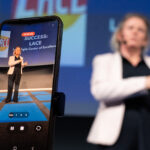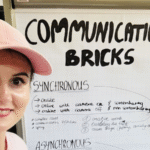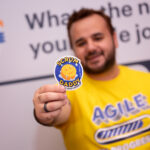
💡 Let’s imagine a conference without a predefined agenda… Sounds weird, right? 🤯 That’s exactly how Agile Lean Europe (ALE) is held. The concept of an open space technology conference is increasingly popular worldwide, used in the agile community and adapted to other groups as well.

This year, we met in Munich (Germany) for three days full of interesting workshops, endless discussions and friendly networking that transformed into strong connections afterwards. The organisers gave us a high-level schedule, and we decided which sessions to attend. How does it work in practice? Let me briefly explain. 🧩
On the first day, the registration started at 8 am and the event began at 9 am. There was time for coffee and networking, with a small icebreaker activity at the very beginning. At 9 am, the event was opened by a fantastic team of organisers! There was an opportunity to get to know more and more people and understand or present, depending on how many times you had taken part in such events, how ALE works (read below more). We created our pods. I was in a group of four people – strangers who became friends later on, because that’s how ALE works. We met first on Wednesday morning to connect, and later on throughout those three days, we kept going back to our pods to share what we had experienced at ALE. Then it was time for agenda creation ✏️ (read below more), and we moved into discussions divided into areas as presented in the picture below. This year, the names of the ‘rooms’ were towns that have hosted ALE in previous years.

It’s worth mentioning that evening activities were also organised! On the first day, there was a 🍽️ “dinner with a stranger” and on the second day, a 🥂 “drink with a friend”. Some people joke that if the dinner goes well, you’ve made a friend and can join the next day’s activity. What’s more, the conference lasted three days: from Wednesday to Friday; however, a day before, some people had already organised networking events, and the weekend afterwards was full of activities like sunbathing, hiking, or sightseeing.
Now it’s time to explain open space technology for those who haven’t experienced it yet – the best part is still to come! The principles are as follows:
- Whoever comes is the right person,
- Whatever happens is the only thing that could have happened,
- Whenever it starts is the right time,
- When it’s over, it’s over.
Another interesting aspect is the way participants move between sessions. We had ten areas (rooms) assigned… so possibly it was up to ten organised discussions at the same time. You know the drill… You cannot be in more than 1 place at once, so you need to choose. You can be bumblebees 🐝 – so flying from one group to another, or like butterflies 🦋, who stay with one group for the whole session to spark discussion. What’s more, the law of two feet works perfectly here. If you are not contributing to the discussion, use your two feet and move to a more interesting place. Sounds intriguing?
Let me also explain a bit how the ✏️ agenda was created , because there is an agenda, but it’s not predefined. It is being created at the beginning of a particular day. Participants have heads full of ideas, and they – or rather, we – are the co-creators of the agenda. You can propose your topic as a giver, so you want to share something with people or as a receiver, essentially indicating that you would like to learn more about a specific topic. You have your piece of paper, note your topic and name there, then queue up to present it in front of everyone. Then it’s time to place your piece of paper on the agenda board. You could arrange a topic for a 30-minute or longer session by adjusting the size of your piece of paper on the board. And then, time to listen to others! Once everyone has added their ideas to the agenda, it’s time to negotiate and decide whether to move them or not – remember, there are up to ten interesting topics at the same time! Below you will find a photo from the first day agenda. I had the pleasure of running the “Communication Bricks” workshop.
How was it from a participant’s perspective? 🧑🤝🧑 It was extremely well organised – but you can expect that from the Germans 😉 The venue was amazing, offering plenty of opportunities for discussion, whether using a flipchart, slides, or just walking around. On the third day, we even played football – can you imagine? 😉 The endless opportunities provided by the people around you.
How was it from the perspective of a ‘speaker’? 🎤 In fact, fantastic. I highly recommend leading at least one session. It gives you a unique understanding of the event. It might be a bit scary for some of the people… Ten discussions were being held at the same time: why did someone choose my session over others? That’s a good question; you get an answer after trying it out. I gave it a chance and don’t regret it at all. The “Communication Bricks” workshop had its premiere during ALE 2025. I had the idea in my head for a while, and I just decided to try it out. Sometimes, overthinking things is not a good idea at all. Check out the pictures from the workshops below.


Do I plan to come next year to ALE 2026 in Belgium? You see this smiling face next to the flipchart? That’s the easiest answer.🚀 It wasn’t my first ALE, and it definitely won’t be my last.






